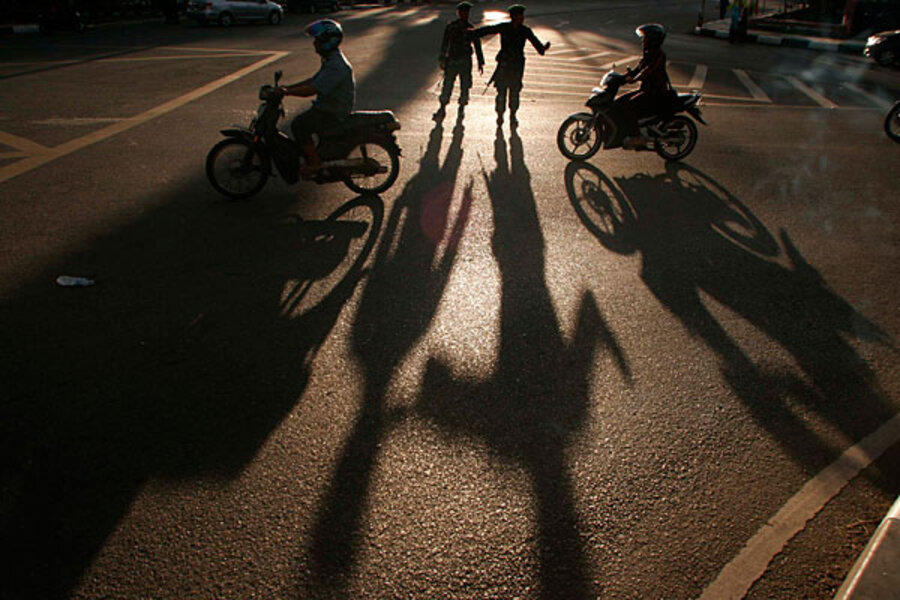Indonesia earthquake: Why no tsunami this time?
Loading...
A powerful earthquake and aftershock struck the Indian Ocean off of northern Indonesia Wednesday, triggering tsunami watches and evacuations throughout the Indian Ocean basin, from Australia to Kenya.
The first temblor, a magnitude 8.6 quake, struck at 2:38 p.m. local time, along a segment of a fault on the sea floor some 269 miles southwest of the coastal city of Banda Aceh, capital of Aceh province. A second, 8.2 magnitude quake struck two hours later roughly 120 miles south of the first quake's epicenter.
Both quakes occurred at relatively shallow depths – 14 miles and 10 miles – beneath the sea floor, according to data gathered by the US Geological Survey's National Earthquake Information Center in Golden, Colo.
So far, the quakes appear to have done little damage and caused no fatalities, although people felt the shaking as far away as the east coast of India. In Banda Aceh, many residents streamed into the streets when the shaking began, according to press reports from the city.
Memories of the disastrous December 2004 earthquake and tsunami remain fresh. The event left 230,000 dead throughout the Indian Ocean basin as the tsunami in some locations reached heights of up to 90 feet.
Though both of Wednesday's large quakes join the magnitude 9.1 event in 2004 event as “great” earthquakes – the strongest of six categories – the initial temblor Wednesday reportedly pushed only a 30-inch-high surge of water onto Indonesia's west coast.
In addition, the 2004 event released nearly six times as much energy as the first quake that struck on Wednesday and some 22 times more energy than the second.
The difference? Location, suggests Amy Vaughan, a geophysicist with the National Earthquake Information Center.
The 2004 rupture occurred along the northern reaches of a subduction zone that hugs the west coast of Indonesia and defines the arc of Indonesia's islands.
The quake occurred in a section of the zone where a vast patch of crust known as the Indian plate is sliding beneath the much smaller Burma plate. Quakes along such subduction zones tend to generate the planet's most violent temblors because the surface areas sliding past each other are large.
Researchers estimate that the patch of the subduction zone affected in the 2004 quake covered an area roughly the size of California. The amount of slip along the length of this patch was 50 feet.
Along the deep-sea trench that marks the subduction zone, the quake lifted the overlying crust several yards. The sudden upward shove along the length of the rupture zone generated the enormous tsunamis the region experienced.
Today's quakes occurred farther offshore and on a different type of fault, Ms. Vaughan explains.
The faults involved Wednesday are so-called strike-slip faults that sit squarely on the Australian plate, another of the plates forming the subduction zone off Indonesia. Strike-slip faults tend to be vertical cracks in the crust. This means that the plates usually slide by each other without radically altering the height of the sea floor.
By contrast, the thrust faults along a subduction zone run diagonally downward from the sea floor as one plate slips under the other. This increases the possibility of disturbing the height of the sea floor. It also means the area of the surfaces sliding past each other is much greater than during a strike-slip rupture.
“We've had a series of these occur since 2004,” Vaughan says, referring to undersea quakes on the Australian plate. The most recent occurred in January – a magnitude 7.2 quake whose epicenter was only about 13 miles from that of the 8.6 quake on Wednesday.
The faults involved in Wednesday's quakes are oriented in the same direction as the general direction of travel the Australian plate itself is following, suggesting that the ruptures are tied to the plate's movement, although to some degree the event also may represent the crust's continued adjustment to the major change the 2004 event brought to the region, Vaughan says.







